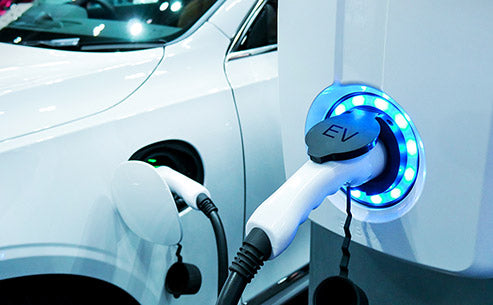
Opportunity 1: Energy utilization must be improved
An electric vehicle is a type of vehicle relative to an internal combustion engine vehicle. It contains at least one power unit as an on-board power supply, which can be driven in whole or in part by electric energy. The significance of electric vehicles is that the on-board energy comes from electricity rather than fossil energy such as gasoline and diesel. Electric vehicles powered by electricity can effectively improve the energy structure, help solve the problem of energy substitution for vehicles, and reduce exhaust emissions. According to estimates, when crude oil is refined into gasoline and diesel and used for driving internal combustion engine vehicles, the average energy utilization rate is only about 12%. And in fact, the energy conversion efficiency of internal combustion engine vehicles is only the efficiency of the engine alone, and only 10% to 15% of the energy of gasoline is converted into driving force. Driving modes such as idling, rapid acceleration, braking and deceleration during parking increase ineffective fuel consumption, and the final conversion efficiency of gasoline is even below 7%. Even if the pure electric vehicle only uses heavy oil to generate electricity, its energy can obtain about 20% of the energy in the motor output shaft through heavy oil refining, power plant thermoelectric conversion, power transmission and distribution, battery charging and motor loss. The energy conversion efficiency of electric vehicles from crude oil to wheel drive is higher than that of gasoline vehicles. If the proportion of electricity generated by renewable energy is increased, the energy utilization rate of electric vehicles will increase significantly.
Opportunity 2: Energy substitution must be solved
Whether the world auto industry can achieve sustainable development must solve the problem of energy substitution. The choice of power source for automobiles is substitutable, and the shortage of petroleum resources makes it an urgent need for new energy vehicles fueled by natural gas and clean electricity to gradually replace traditional internal combustion engine vehicles. Vigorously developing energy-saving and new energy vehicles, while reducing vehicle fuel consumption, increasing the use of natural gas, biomass, electricity, hydrogen and other energy forms is an inevitable choice for vehicle energy sources and development strategies.

Opportunity 3: Electric vehicles change the lives of car owners
In addition to high energy utilization and alternative clean energy, the carbon emissions of various electric vehicles can be greatly reduced during road driving, and pure electric vehicles can also achieve zero emissions, which significantly reduces the degree of air pollution in urban areas. Because electric energy is relatively cheap, it can save fuel costs to a large extent for users of electric vehicles. In addition, pure electric vehicles have no other noises except airflow noise and tire noise during driving, which can significantly reduce vehicle noise pollution. In addition, electric vehicles also have many advantages in terms of performance, such as superior acceleration performance and smooth driving, so they have also attracted extensive attention from car owners. With the development of the automobile industry and the advancement of science and technology, the performance of electric vehicles will gradually catch up with traditional internal combustion engine vehicles, and electric vehicles will usher in better development opportunities.
The definition of new energy vehicles in the "New Energy Vehicle Production Access Management Rules" formulated and implemented by China is as follows: New energy vehicles refer to vehicles that use unconventional vehicle fuels as power sources (or the use of conventional vehicle fuels and the use of new vehicle-mounted power units), integrate advanced technologies in vehicle power control and driving, and form advanced technical principles with new technologies and new structures. Facing the challenges of energy shortage and environmental pollution, it has become inevitable to develop energy-saving and new energy vehicle technologies. New energy vehicles include hybrid vehicles, pure electric vehicles, fuel cell electric vehicles, hydrogen energy vehicles and other types of new energy vehicles.
The most important component of the electric vehicle drive system is the electric motor, and in almost all performance indicators, the electric motor is superior to the traditional fuel engine. At the same power output, the electric motor has a smaller volume and lower mass, and also has the advantages of fewer moving parts, less noise and less maintenance. The electric motor does not need an ignition system, an oil supply system and an exhaust system, and the efficiency of the electric motor is also very high and the heat generation is small. More importantly, electric motors tend to have higher torque and wider rated torque output range, so they can effectively combine start-up acceleration performance with excellent cruising performance. The internal combustion engine of a traditional gasoline vehicle is inefficient in congested urban road conditions, while an electric vehicle with a high-power electric motor is significantly different. In addition, pure electric vehicles may not use gearboxes, while internal combustion engine vehicles have to use very complex transmissions in order to improve the driving torque and drivability of vehicles at low speeds.
The main problem faced by electric vehicles is the short driving range under pure electric driving conditions, as well as other deficiencies such as expensive batteries and time-consuming charging. Charging and driving range are common bottlenecks encountered in the early stage of electric vehicle promotion, which restricts the popularity of electric vehicles among consumers. Electric vehicles (especially pure electric vehicles) are more suitable as commuter vehicles for urban commuting under the existing technical conditions. When faced with occasional long-distance travel needs, you must arrange for charging along the way, or choose a hybrid or extended-range hybrid vehicle. The best electric car in the world right now can't outpace a low-priced internal combustion engine car in long-distance driving.
















